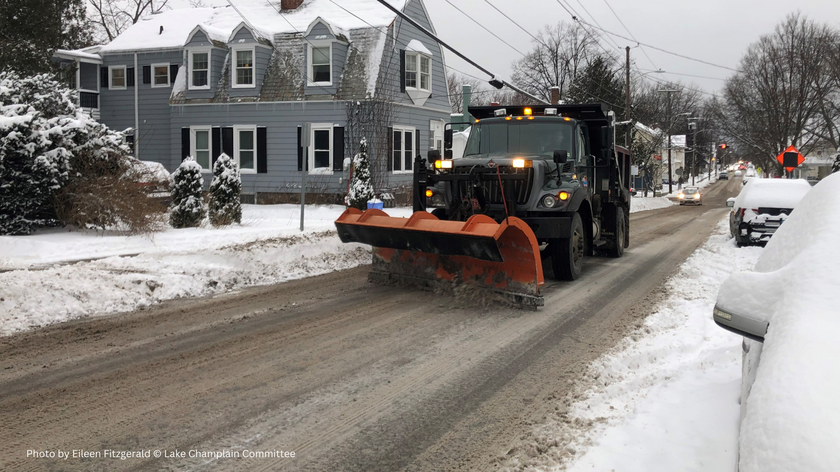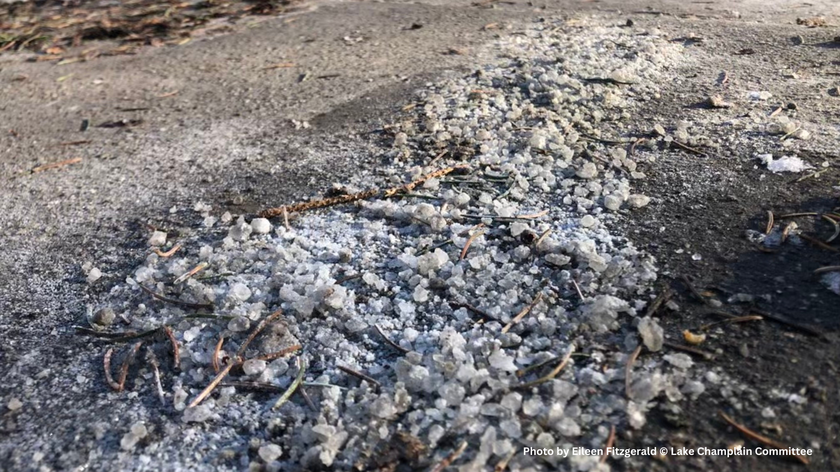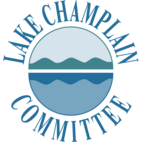The Hidden Cost of Winter–How Road Salt is Undermining Infrastructure
February 2025 Lake Look
It’s a familiar winter symphony in the Lake Champlain basin: snow, ice, and coarse rock salt crunch beneath your boots as you walk down the pavement. However, below the caked layers of snow, a quieter crisis is unfolding. Spreading road salt in pursuit of safer roads and sidewalks produces a cascade of unintended consequences that persist long after winter is over, corroding bridges, damaging roads, and compromising water systems.
Seeing road salt and other additives being spread on winter roads is nothing new. Yet it raises an important question: why can’t we put our roads on a low-sodium diet?

The use of road salt in the United States began in 1938 when New Hampshire began experimenting with salt as a deicer. It quickly gained popularity, and by the winter of 1941 about 5,000 tons of salt, typically sodium chloride, were applied to roads throughout the country. But salt’s effectiveness at melting ice comes with hidden costs. Once the ice is gone, the salt doesn’t simply disappear—it seeps into the environment, affecting not just ecosystems but the infrastructure designed to serve our communities.
Metal structures are particularly vulnerable. Chloride ions are corrosive, accelerating the oxidation of steel. Bridges and water pipes suffer as their structural integrity is slowly compromised. Metal stormwater culverts exposed to salt-laden runoff rust to the point of failure, leading to expensive repairs. As salt-laden runoff enters wastewater and drinking water systems, it can erode pipes and leach harmful substances. In Flint, Michigan, salt-contaminated freshwater leached lead from the city’s old water pipes, causing a water crisis that was exacerbated by systemic racism – but one that could occur anywhere with high-salt runoff and lead pipes.
Corrosive road salt affects private property as well. A recent analysis by the New York Department of Environmental Conservation’s Adirondack Road Salt Reduction Task Force highlighted impacts on homeowners using well water. Within the Adirondack Park, 31% of homeowners may experience corrosive damage to plumbing, fixtures, and appliances due to road salt contamination in well water. Notably, 73% of affected homes were built before the federal Safe Drinking Water Act was amended in 1986 to prohibit lead in plumbing and fixtures. The source of contamination—whether surface runoff, groundwater, or a combination—requires further study, but the findings reveal that watersheds receiving road runoff are at significantly higher risk.
Concrete infrastructure also suffers. When salt-laden water seeps into tiny cracks, it freezes and expands during cold spells, causing the surface to break apart. This freeze-thaw cycle creates potholes, crumbling sidewalks, and weakened parking garages, all of which add to the financial burden of winter maintenance. Over time, salt accelerates the degradation of not just the concrete itself but also the steel reinforcements embedded within. These structural failures come at a staggering financial cost to municipalities struggling to maintain their aging infrastructure.

Rethinking Salt Use: Strategies and Solutions
Luckily, there are solutions to the damage caused by road salt, and states are moving to implement new systems. For individuals, you can salt your driveway or sidewalk strategically: Salt before snowfall, use a 23% saltwater (brine) solution rather than rock salt, shovel before applying, use only as much as needed, and sweep up excess for re-use. Do not apply salt on concrete, gravel, or dirt; salt applied to an unpaved surface is even more harmful for the environment and can cause dangerous conditions for driving. Regardless of surface, no salt should be applied when temperatures are below 16 degrees Fahrenheit, as salt will not thaw ice at these low temperatures.
In 2020, New York enacted the Randy Preston Road Salt Reduction Act, which led to the formation of the Adirondack Road Salt Reduction Task Force. The Task Force's 2023 final report highlighted the need for best management practices, enhanced training for road maintenance crews, and public outreach to support road salt reduction. Community initiatives, like the "Pledge to Reduce Road Salt" promoted by AdkAction, have seen 27 Adirondack communities commit to environmentally conscious practices for road salt use. Towns including Hague and Lake George have made significant progress, with Hague reducing salt application by nearly 70% between 2016 and 2021 through investments in brine systems, live-edge plows, and surface temperature sensors. Communities achieved significant cost savings, with Washington County alone saving over $300,000 annually through technologies that ensure precise and efficient salt application while minimizing runoff. Resources like Lake Champlain Sea Grant’s deicing calculator assist municipalities and private applicators in optimizing salt use based on surface type and temperature.
Vermont is now poised to follow suit. The Vermont legislature is considering a measure backed by the Lake Champlain Committee that would establish the Chloride Contamination Reduction Program at the Agency of Natural Resources (ANR), with the goal of reducing chloride in surface and groundwater across the state. Under the bill, ANR would collaborate with the Vermont Agency of Transportation to train commercial and municipal salt applicators in best management practices for efficient salt application and the prevention of water contamination. Certified applicators using these practices would be presumed to comply with water quality laws, and there would be liability protections for certified applicators and those whose properties they maintain. The bill would also regulate salt storage facilities and require water quality monitoring where high chloride levels are found in surface water.
The cracks in our roads and the rust on our bridges tell a story of unintended consequences. As winter settles in, the reality is stark: the very tool designed to keep us safe is quietly eroding the structures we depend on. Yet, the successes in New York and the promise of change in Vermont show that solutions are within reach. With concerted effort and innovation, it is possible to strike a balance — preserving public safety without sacrificing the integrity of our environment or built infrastructure.
Lake Look is a monthly natural history column produced by the Lake Champlain Committee (LCC). Formed in 1963, LCC is a bi-state nonprofit that uses science-based advocacy, education, and collaborative action to protect and restore water quality, safeguard natural habitats, foster stewardship, and ensure recreational access. You can join, renew your membership, make a special donation, or volunteer to further our work.
